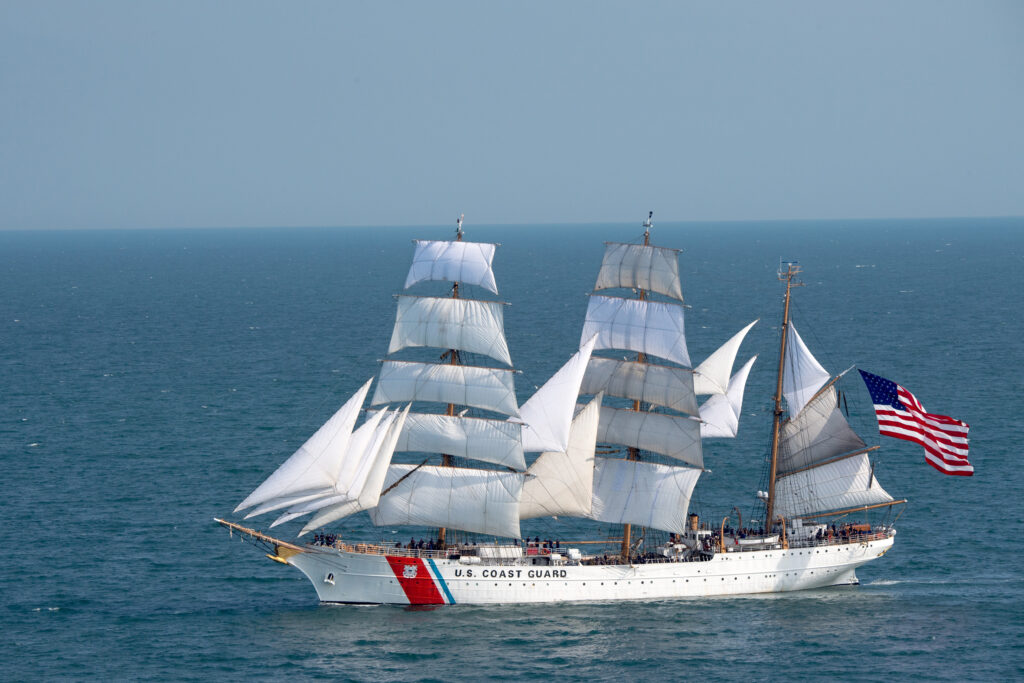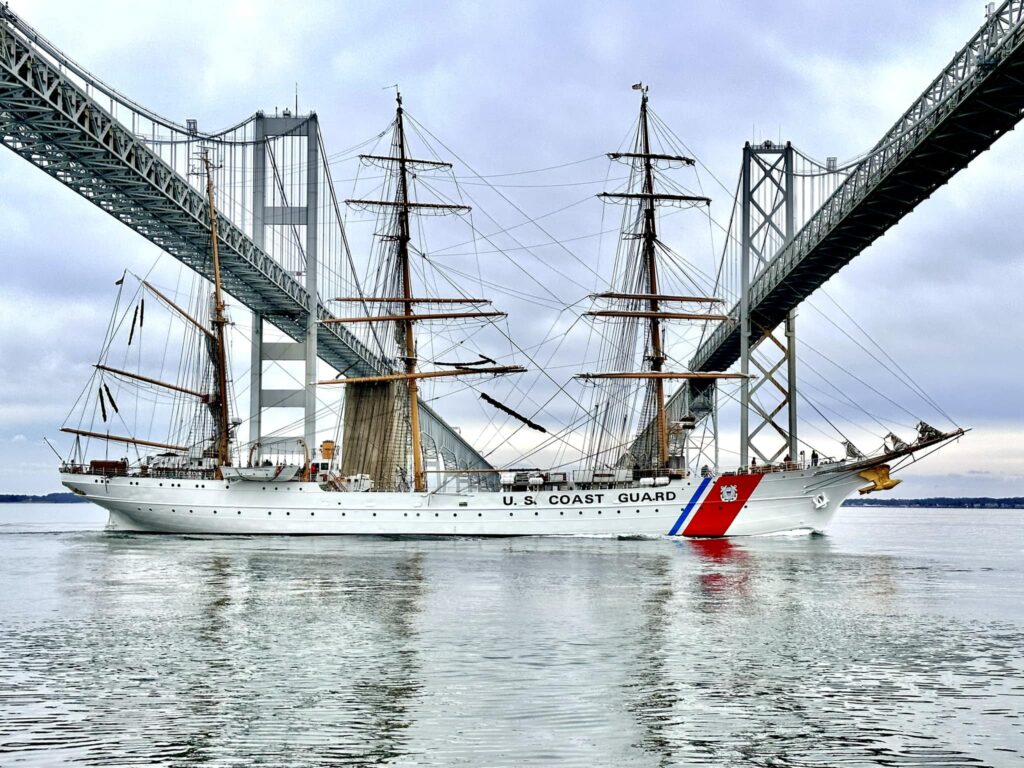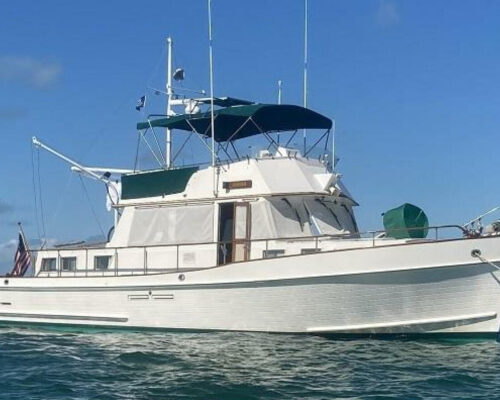The U.S. Coast Guard Cutter Eagle is a bit of an odd duck. A relic from the trailing edge of the great age of sail that has stubbornly persisted, through world wars and budgetary concerns, into the 21st century. The Eagle is a holdover that has managed to find its niche among the icebreakers, offshore patrol cutters, and go-fast drug interdicters of the modern Coast Guard.
The 295-foot head-turner carries 21,350 square feet of sail over three masts, two of which (the fore and main) carry square sails. That specific configuration of sails makes her a barque. The only active commissioned sailing vessel in the U.S. military, The Eagle is not a particularly fast ship. But that is not her job. The Coast Guard claims a maximum of 17 knots under sail, and her square sails allow a limited point of sail, only allowing for her crew to steer around 70 degrees off the wind.
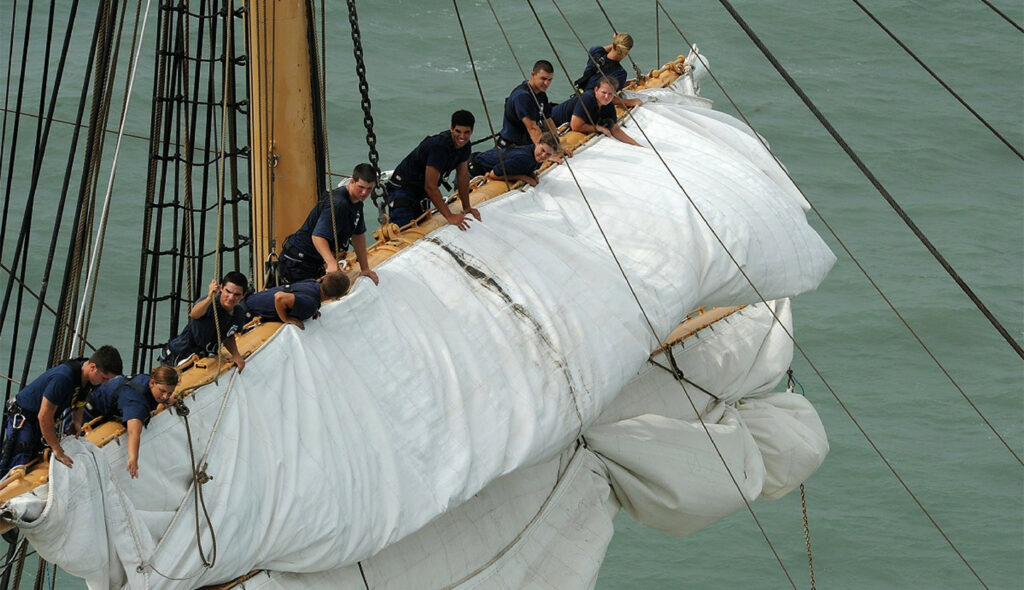
While there are motorized winches and the like to help manage the heavy yards and sails, they mostly go unused. The ship was built to run on the power of young sailors—pulling on ropes to bring the yards around the mast to wear ship [Editor’s note: that’s tacking, to us fiberglass boaters], or flying aloft to loose the royals [the smallest sails at the top], where the height and heel of the boat make the water seem almost close enough to touch.
The ship was built for training sailors in the lore and mechanics of the sea and wind, and it is intentionally complex, a monument to the idea that some things can only be learned by doing them the hard way. It is similar to a modern Coast Guard cutter in the same way that a grandfather clock is similar to a smartwatch, and like a grandfather clock, it is a beautiful and complex machine.
Leland Currier is one of the people responsible for keeping the machine ticking, and like the ship he keeps returning to, he seems to have found his niche. As the 1st Lieutenant, or Sailmaster, of Eagle, Currier is responsible for maintaining and overseeing the operations of the sails, the rigging, and largely everything above the deck of the nearly 100-year-old ship. While the Eagle is home-ported in New London, Connecticut, in recent years it has spent the winters in the Coast Guard yard in Curtis Bay, just south of Baltimore, undergoing maintenance. Currier, who is from Anne Arundel County (“I grew up at the headwaters of this creek,” he points from the yard near where Eagle is berthed), is in his seventh year on the Eagle, spread over three tours and five visits to this shipyard.
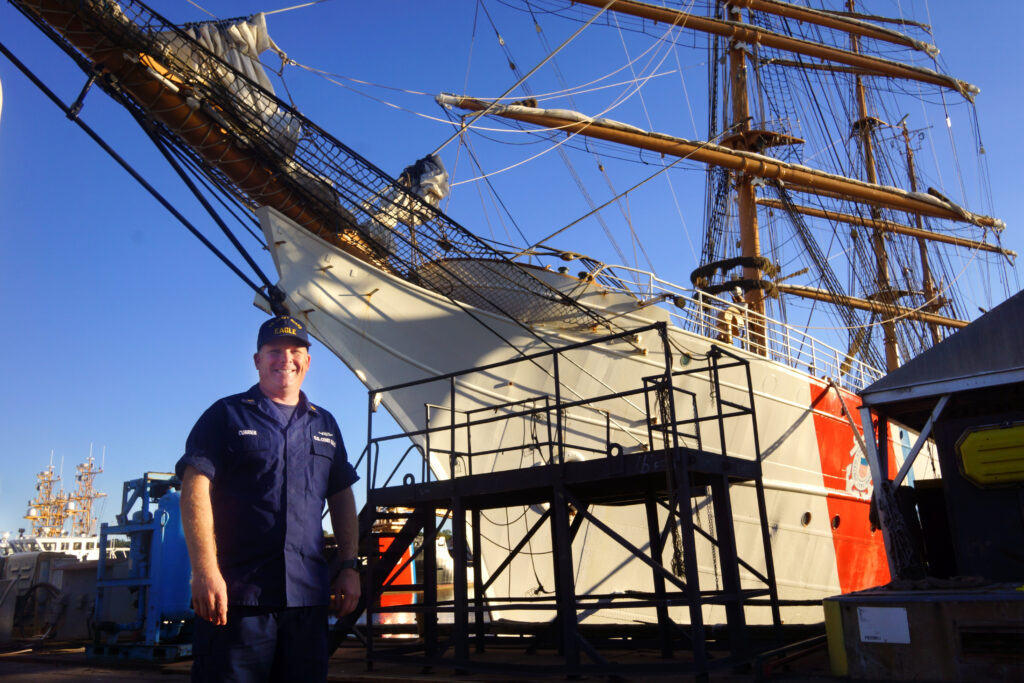
One of the ship’s main purposes is to train cadets from the Coast Guard Academy in the ways of the sea, but Currier wasn’t one of those. “I was an enlisted member,” he says, grinning. “I chose it.”
It wasn’t necessarily the romance of the sailing life that drove him—Eagle was the first sailboat he ever stepped aboard. “I was not sure how long I was going to stay in the Coast Guard, and speaking to some people about it, if I was planning on doing only four years, why not go somewhere that’s going to take me around the world?”
Currier had been on large cutters before, as he trained to be a bosun’s mate. Still, his first view of his new ship was daunting. “I was like, okay, cool, this is going to be fun. And then I remember walking over the hill at Fort Trumbull in New London and thinking, ‘What the heck did I just get myself into?'”
Once he started to make sense of the six miles of rigging, he found he enjoyed it. His first tour, from 2005 to 2008, took him to Europe, the Caribbean, and the West Coast of the United States. “I didn’t have a bad go, if I was only going to do four years.” He has also spoken to his then-commanding officers since that tour, who assure him that awakening the crew at two in the morning to fly aloft and stow sail or muscle the heavy yards to a different point of sail was “planned into the day,” a notion he seems mildly skeptical of in retrospect.
In 2020, Currier returned to the sailing ship for two years after time spent tending to Bay navigation aids out of Crisfield and Baltimore. He then took a break from the big ship, knowing he would likely return again. He is part of a small community of Eagle sailors who rely on each other for the sort of knowledge that only comes through experience.
“I always liked it,” he says. “On my first tour, everybody told me to be prepared to come back, and now that I’m on my third tour, I still run into people and say, be prepared to come back. It’s such a weird niche I guess … so having at least some knowledge of the ship helps with the safety of the ship.”
Modern electronics and weather predictions have, even over a blip in time like 20 years, lessened the need for 2 a.m. wakeups, but the core mission of the ship, that of training young recruits for the rigors and discipline of life at sea, has remained the same since the Eagle was first put into service by, well, the Nazis.
The Eagle was originally named Horst Wessel, after a young stormtrooper and law-school dropout. Wessel was killed in 1930 during a somewhat confusing dispute with a man who was, depending on the source, either boyfriend or pimp to Wessel’s girlfriend. Nazi propagandist Joseph Goebbels seized an opportunity by claiming the assailant was a communist, and used the occasion to make Wessel a martyr for the burgeoning Nazi cause.
A poem Wessel had written was set to music as the Nazi anthem, and he was further memorialized in 1936 when, with Adolph Hitler in attendance, Wessel’s mother cracked a bottle of champagne to christen the barque Horst Wessel as the flagship of the German sail training fleet. It spent most of World War II representing Nazi Germany in various capacities, until 1945, when the captain took a group of refugees aboard and, perhaps attuned to the prevailing winds, sailed off and surrendered to the British.
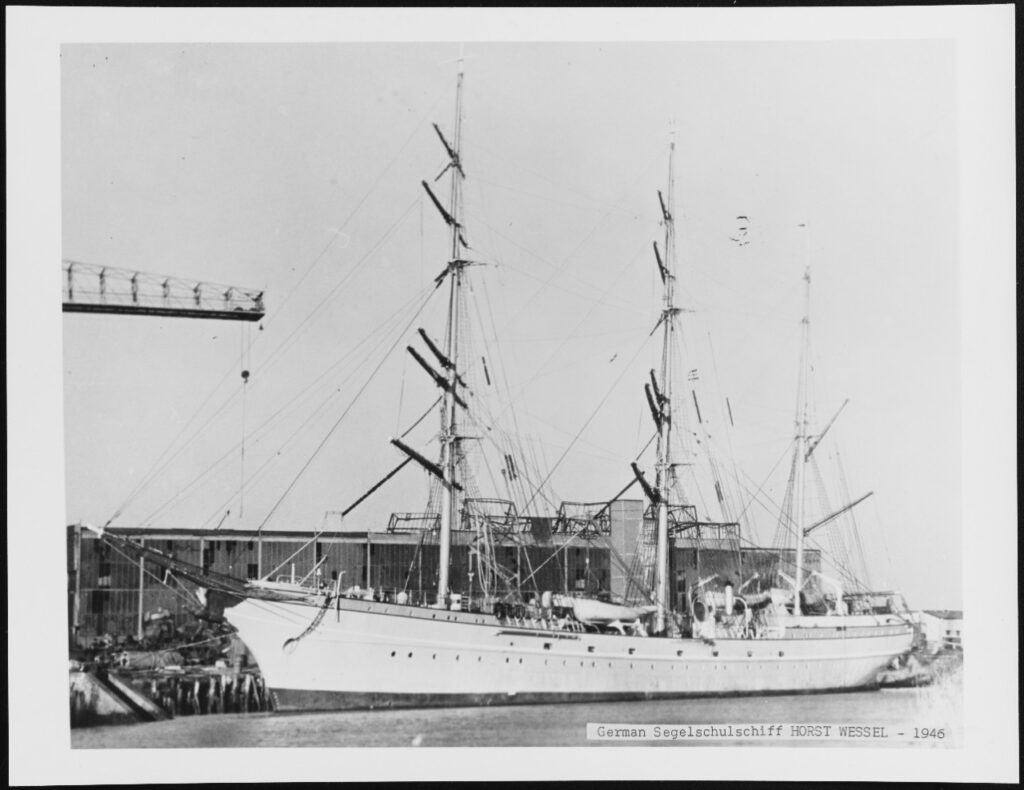
After the war, the allies divvied up Horst and its three sister ships, all of which are still around: the Albert Leo Schlageter (now the Portuguese Navy’s NRP Sagres), Mircea (actually Romanian, but still taken by the Soviet Union, and currently Romanian again), and the Gorch Fock (briefly the Soviet Tovarishch, currently a museum ship in Straslun, Germany which, if internet reviews are to be believed, has seen better days).
Eagle is unique in the U.S., but military sail training is not the anachronistic pursuit it might seem. From the Italian Navy’s full-rigged Amerigo Vespucci to Argentina’s ARA Libertad (a hit when it visited Baltimore this summer), these giants still prowl the seas worldwide, showing young sailors the literal ropes. The Coast Guard, in particular, has had a sail training component since its formation as the United States Revenue Cutter Service in 1878.
An 1886 Harper’s Magazine article describes the aim of sail training Coast Guard cadets which, despite the antiquated language, seems to have changed little:
“He has a taste of the sternest and most trying obligations at the threshold of his undertaking, which results in a pretty thorough test of his metal [sic], and if any one is actually unfit for the sea, physically or otherwise, the fact is at once brought to the surface, and gives him an opportunity to turn back at the beginning of a career in which he would not be likely to succeed.”
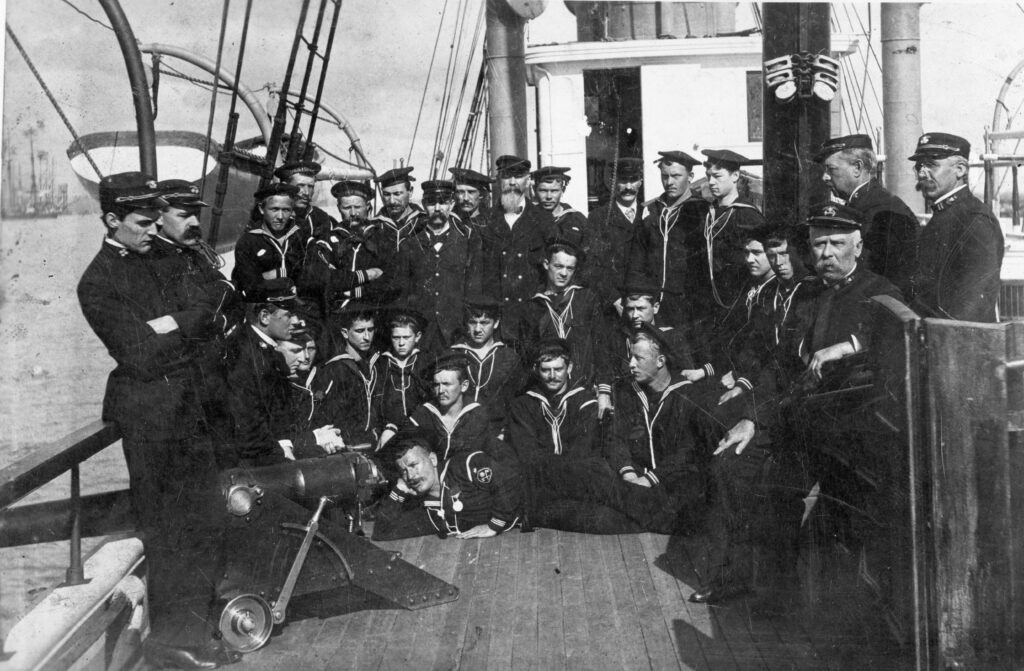
Modern Coast Guard Cadets spend about a month and half on the Eagle, learning damage control, helm lookout, and standing an engineering watch—the general stuff one does on any boat, with the added rigors of a traditional square rig.
“What we’re doing with Eagle is supporting the academy’s goal of delivering fleet-ready ensigns,” Currier says, “so when that person graduates the academy and heads out to a [modern] ship, they’re ready with a basic knowledge to serve onboard.”
A second part of the mission should be obvious to anyone who has seen the graceful barque Eagle coming into port—it’s there to impress.
“We’re a goodwill ambassador,” Currier says. “We go around, flying the American flag, showing what the Coast Guard can do, and supporting diplomatic affairs overseas.”
And the allure of the ship is undeniable, even for someone like Currier, who knows every thump and creak of the rigging.
“There’s definitely a romance about it,” he admits. “It’s a lot of hard work, but you see the fruits of your labor when you’re under full sail in a moderate breeze and the ship’s heeling at about 15 degrees, and you’re doing 13 knots. When you’re going faster under sail than the engine can take you. There’s something to be said about that, and there is a romance about it still.”
